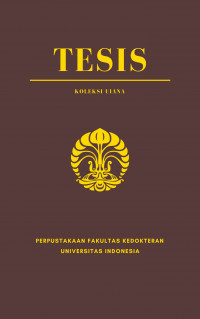Tesis
Pengaruh Usia Awitan Kejang dan Jumlah Hemisfer Fokus Kejang terhadap Komorbiditas Kognitif dan Perilaku Anak-anak dengan Epilepsi Rolandik = The Effect of Seizure Age of Onset and Number of Seizure Focus Hemispheres on Cognitive and Behavior Comorbidities in Children with Rolandic Epilepsy.
Latar belakang: Epilepsi Rolandik adalah salah satu sindrom epilepsi terbanyak pada anak dan umumnya dianggap benign dan self-limited. Tetapi komorbiditas kognitif dan perilaku dapat ditemukan pada anak-anak dengan epilepsi yang bernama lainnya benign Rolandic epilepsy with centrotemporal spikes (BECTS) ini. Pasien epilepsi Rolandik harus dievaluasi adanya komorbiditas kognitif dan perilaku. Tujuan: Mengetahui hubungan antara usia awitan kejang dan jumlah hemisfer yang menjadi fokus kejang dengan kemampuan kognitif dan gangguan perilaku pada anak-anak dengan epilepsi Rolandik. Metode: Penelitian potong-lintang di sembilan RS/klinik dengan konsultan neurologi anak di Jakarta dan Banten, terhadap anak-anak berusia 6 – 12 tahun dengan epilepsi Rolandik. Penelitian meliputi anamnesis semiologi kejang, interpretasi hasil elektroensefalografi (EEG) oleh dua orang konsultan neurologi anak, dan pemeriksaan intelligence quotient (IQ) oleh psikolog. Hasil: Nilai verbal IQ sebagai parameter kognitif berbicara/berbahasa lebih banyak bernilai average pada subjek dengan usia awitan kejang yang lebih muda (< 6 tahun). Nilai verbal IQ < average lebih banyak didapatkan pada subjek dengan fokus gelombang kejang pada salah satu sisi hemisfer. Jumlah subjek yang mengalami gangguan perilaku berupa gangguan pemusatan perhatian dan hiperaktivitas (GPPH) dan gangguan spektrum autism (GSA) lebih banyak pada kelompok usia awitan kejang < 6 tahun dan fokus kejang hemisfer bilateral. Tidak ada hubungan yang bermakna secara statistik antara usia awitan kejang dan jumlah hemisfer yang menjadi fokus kejang dengan komorbiditas kognitif dan perilaku. Simpulan: Anak-anak dengan epilepsi Rolandik dapat memiliki komorbiditas kognitif berupa gangguan berbicara/berbahasa dan komorbiditas perilaku berupa GPPH/GSA, dan dapat dipengaruhi oleh usia awitan kejang dan jumlah hemisfer yang menjadi fokus kejang, meskipun hubungannya tidak bermakna secara statistik.
Kata kunci: Epilepsi Rolandik, gangguan berbicara dan berbahasa, tes IQ.
Background: Rolandic epilepsy is one of the most common epilepsy syndromes in children and is generally considered benign and self-limited. But cognitive and behavioral comorbidities can be found in children with this epilepsy, which has another name: benign Rolandic epilepsy with centrotemporal spikes (BECTS). Rolandic epileptic patients should be evaluated for cognitive and behavioral comorbidities. Objective: To determine the relationship between age at onset of seizures and the number of hemispheres that are the focus of seizures with cognitive abilities and behavioral disorders in children with Rolandic epilepsy. Methods: Cross-sectional study in nine hospitals/clinics with pediatric neurology consultants in Jakarta and Banten, on children aged 6-12 years with Rolandic epilepsy. The research includes interviews on seizure semiology history, interpretation of electroencephalographic (EEG) results by two child neurology consultants, and intelligence quotient (IQ) tests performed by psychologists. Results: The verbal IQ score as a cognitive speaking/language parameter average was found more in subjects with younger seizure onset ( < 6 years). Verbal IQ < average scores were greater in subjects with seizure focus on one side of the hemisphere. The number of subjects who experienced behavioral disorders in the form of attention deficit hyperactivity disorder (ADHD) and autism spectrum disorders (ASD) was more in the age group of seizure onset < 6 years and bilateral hemispheric seizure focus. There was no statistically significant relationship between age at onset of seizures and the number of hemispheres that were the focus of seizures with cognitive and behavioral comorbidities. Conclusion: Children with Rolandic epilepsy may have cognitive comorbidities in the form of speech/language disorders and behavioral comorbidities in the form of ADHD/ASD, and may be affected by the age of seizure onset and the number of hemispheres that are the focus of seizures, although the relationship is not statistically significant.
Keywords: Rolandic epilepsy, speech and language disorders, IQ test
- Judul Seri
-
-
- Tahun Terbit
-
2021
- Pengarang
-
Arifianto - Nama Orang
RA Setyo Handryastuti - Nama Orang
Frida Soesanti - Nama Orang - No. Panggil
-
T21034fk
- Penerbit
- Jakarta : Sp-2 Ilmu Kesehatan Anak., 2021
- Deskripsi Fisik
-
xv, 76 hal; ill; 21 x 30 cm
- Bahasa
-
Indonesia
- ISBN/ISSN
-
-
- Klasifikasi
-
NONE
- Edisi
-
-
- Subjek
- Info Detail Spesifik
-
Tanpa Hardcopy
| T21034fk | T21034fk | Perpustakaan FKUI | Tersedia |


Masuk ke area anggota untuk memberikan review tentang koleksi